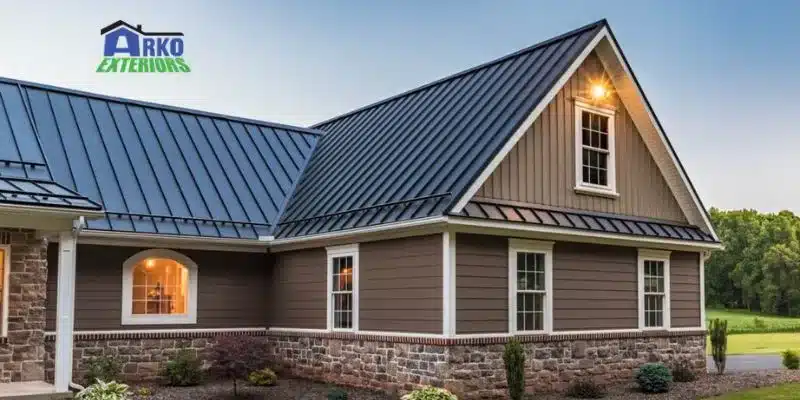When it comes to the aesthetics of your home, the roof plays a pivotal role in defining its overall appeal. Beyond its functional purpose of sheltering your household, the roof serves as a prominent feature that contributes significantly to the curb appeal of your property. Choosing the right roof can elevate the visual impact of your home’s exterior, making it stand out in the neighborhood. Let’s explore how the right roof can transform the look and feel of your home.
1. Architectural Harmony
The roof is a key architectural element that should complement the style and design of your home. Whether your house boasts a traditional charm, modern sleekness, or rustic appeal, selecting a roof that aligns with the architectural style can enhance its visual coherence. For instance, a Victorian-style home might benefit from the intricate details of a steeply pitched roof with ornate shingles, while a contemporary dwelling could embrace the clean lines of a flat or low-slope roof.
2. Material Matters
The choice of roofing material significantly impacts both the aesthetics and functionality of your home. From classic asphalt shingles to eco-friendly options like metal or clay tiles, each material imparts a distinct character to your roof. Consider the texture, color, and durability of the material in relation to your home’s exterior palette and climate conditions. A well-chosen roofing material not only enhances curb appeal but also adds value and longevity to your property.
3. Color Coordination
The color of your roof can dramatically transform the overall look of your home. Opting for a roof color that complements or contrasts with the siding, trim, and other exterior elements can create visual interest and depth. Neutral hues such as shades of gray, brown, or tan offer timeless appeal and versatility, while bolder tones like deep blue or forest green can make a striking statement. Harmonizing the roof color with the surrounding landscape and architectural features enhances the cohesive aesthetic of your home’s exterior.
4. Texture and Dimension
The texture and dimension of the roofing material add richness and character to your home’s exterior. Whether you prefer the rustic charm of cedar shakes, the sleek finish of metal panels, or the classic look of slate tiles, the texture of the roof contributes to its visual impact. Additionally, incorporating architectural details such as dormers, gables, or cupolas enhances the depth and dimension of the roofline, creating visual interest and elegance.
5. Enhancing Energy Efficiency
Beyond aesthetics, the right roof can also improve the energy efficiency and sustainability of your home. Investing in high-quality insulation, reflective coatings, and ventilation systems can help regulate indoor temperatures, reduce energy consumption, and lower utility bills. Moreover, choosing eco-friendly roofing materials made from recycled content or renewable resources minimizes environmental impact and contributes to a greener future.
6. Roofline and Silhouette
The shape and slope of the roofline significantly influence the overall silhouette and character of your home. Whether you opt for a traditional gable roof, a contemporary flat roof, or a dramatic mansard roof, each style imparts a distinct personality to your property. Consider the architectural proportions and visual balance to create a harmonious roofline that complements the overall design aesthetic.
7. Weather Resistance and Durability
In addition to aesthetics, durability and weather resistance are paramount considerations when selecting a roof. Choose materials that can withstand the local climate, including heavy rain, snow, wind, and temperature fluctuations. Investing in a resilient roof not only protects your home from environmental elements but also minimizes maintenance costs and ensures long-term structural integrity.
8. Maintenance and Longevity
Regular roofing maintenance is essential to preserve the beauty and functionality of your roof over time. Selecting low-maintenance materials and finishes can simplify upkeep and extend the lifespan of your roof. Additionally, partnering with reputable roofing professionals for inspections, repairs, and preventative maintenance ensures that your roof remains in optimal condition for years to come, enhancing its longevity and value.
9. Historical and Regional Influences
Consider the historical and regional influences when choosing a roof style and material for your home. Certain architectural styles are prevalent in specific geographic regions, reflecting local traditions, climate considerations, and cultural preferences. Drawing inspiration from historical precedents and regional vernacular architecture can evoke a sense of place and heritage while adding a unique charm to your home’s exterior.
10. Regulatory Compliance and Building Codes
Ensure compliance with local building codes, zoning regulations, and homeowners’ association guidelines when designing and installing your roof. Familiarize yourself with permit requirements, setback regulations, and design standards to avoid potential legal issues and ensure that your roof project meets safety and structural requirements. Consulting with professionals and obtaining necessary approvals beforehand streamlines the construction process and ensures peace of mind.
Conclusion
In conclusion, the roof serves as a cornerstone of your home’s exterior design, offering both functional protection and aesthetic appeal. By carefully considering factors such as architectural style, material selection, color coordination, texture, and energy efficiency, you can transform your home’s curb appeal and create a lasting impression. Whether you’re embarking on a new construction project or planning a roof replacement, investing in the right roof is a decision that pays dividends in terms of beauty, durability, and value. You must always focus on consulting a professional roofing company for any roofing requirement.

